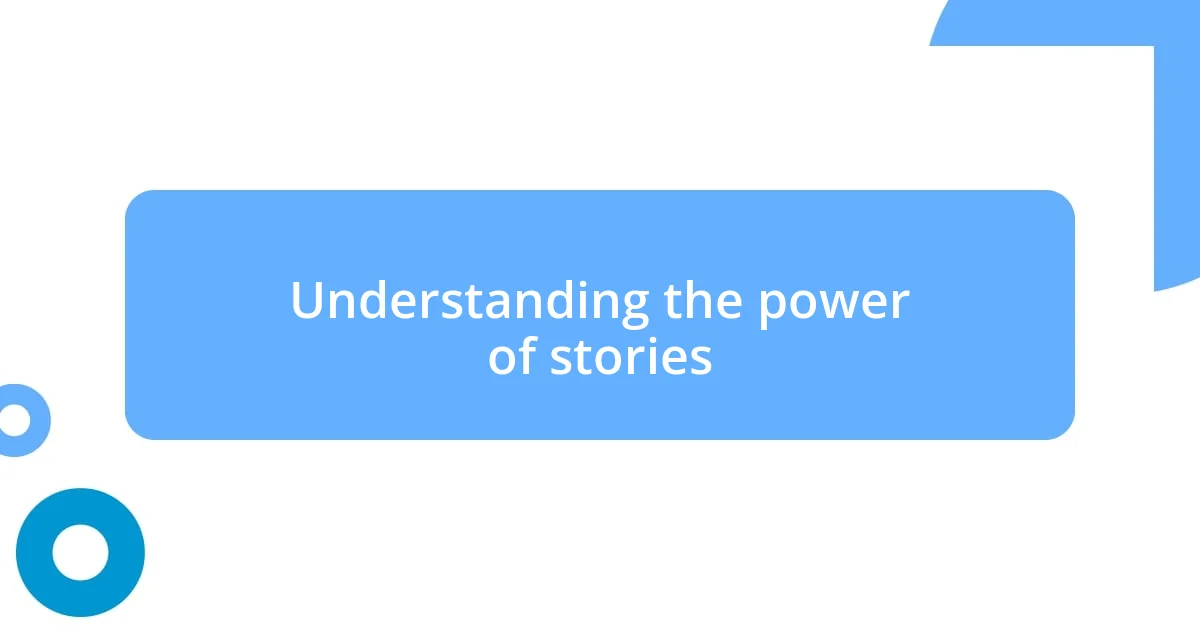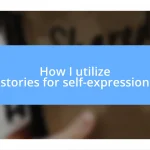Key takeaways:
- Stories foster emotional connections and shared vulnerability, helping individuals confront their feelings and discover clarity.
- Effective personal narratives combine authenticity, sensory details, and growth reflections to engage readers deeply.
- Overcoming barriers to self-expression involves embracing vulnerability, allowing for exploration in storytelling, and recognizing the uniqueness of each individual’s narrative.

Understanding the power of stories
Stories hold a remarkable power to connect us on a deeply emotional level. I remember a time when I stumbled upon a friend’s blog detailing their struggles with anxiety. It changed my perspective completely and made me feel less isolated in my own experiences. Have you ever felt a sudden bond with someone just because their story mirrored your own? It’s that shared vulnerability that gives stories their strength.
I often think about how stories shape our worldviews. For instance, during a recent conversation with my grandmother about her childhood during the war, I realized how her resilience influenced my life’s outlook. The way she recounted her experiences painted vivid images in my mind, teaching me lessons about perseverance and hope. Doesn’t it seem incredible how a simple narrative can alter the course of our thoughts and feelings?
Through storytelling, we can articulate our inner thoughts in ways that raw facts just can’t. I find solace in writing about my emotions—not just as an outlet but as a way to process my experiences. I’ve discovered that when I tell my story in detail, I can confront the chaos inside my head and transform it into something meaningful. Have you ever tried expressing your feelings through a story? If so, you might have felt a sense of clarity emerge from those words.

Crafting personal narratives effectively
Crafting personal narratives effectively requires a blend of authenticity and engagement. I recall sitting down one afternoon to write about a road trip I took with my best friend. As I began to relive the laughter, the mishaps, and the breathtaking landscapes, I realized those details allowed me to draw readers in. By focusing on sensory experiences, like the smell of pine trees or the warmth of the sun on my skin, I created a vivid sense of place that resonated deeply with those who read it.
To create your own compelling narrative, consider these elements:
- Start with emotion: What feeling do you want to convey?
- Use specific details: Eye color, sounds, and scents can transport your reader.
- Reflect on lessons learned: Readers connect with growth and transformation.
- Keep it authentic: Write in your own voice, allowing your personality to shine.
- Engage the senses: Make them feel, see, and experience alongside you.
These components not only enhance your storytelling but also foster a deeper connection with your audience, inviting them into your world. I once crafted a piece about learning to dance later in life, and sharing my fears and eventual triumph turned a simple story into a shared journey that many could relate to.

Techniques for engaging storytelling
When it comes to engaging storytelling, I always emphasize the importance of structure. I once participated in a storytelling workshop where we learned about the classic arc: introduction, rising action, climax, falling action, and resolution. This structure helped me organize my thoughts effectively. For example, while recounting my first experience of public speaking, I laid out the tension of a looming audience, the moment I stumbled, and how I eventually regained my confidence. It wasn’t just about what happened; it was about the emotional journey that made it relatable.
Incorporating dialogue can also breathe life into your narrative. I vividly remember a conversation with my older brother where he shared a piece of advice that stuck with me for years. By weaving dialogue into my stories, I allow readers to “hear” the voices of my past. Have you ever noticed how dialogue can shift the tone or mood? It creates intimacy, making the reader feel as though they’re part of the conversation.
Another technique I’ve found powerful is using metaphors and similes. When I describe feelings, like heartbreak, I often say it feels like a sudden storm ripping through a calm day. This vivid imagery can resonate emotionally with readers. They can almost feel the chaos. Have you considered how imagery can transform your storytelling? It’s these vivid comparisons that can make your experiences feel universal, drawing others into your emotional world.
| Technique | Description |
|---|---|
| Story Arc | A classic structure that organizes the narrative into clear stages, enhancing emotional impact. |
| Incorporating Dialogue | Brings characters to life and creates intimacy by sharing authentic conversations. |
| Metaphors and Similes | Utilizes vivid imagery to express feelings, making the emotional experience relatable and evocative. |

Overcoming barriers to self-expression
Self-expression can be stifled by various barriers, including fear of judgment and the struggle to articulate complex emotions. I remember grappling with the anxiety of sharing my writing in a group setting. The thought of others critiquing my work kept me from voicing what truly mattered until I realized that vulnerability could foster connection. Have you ever felt that way? Once I began to embrace my raw emotions and shared my narrative, I noticed not only a sense of relief but also a strong bond with the listeners; they could relate to my struggle.
Another significant barrier is the tendency to overthink the process of storytelling. I’ve caught myself getting lost in the endless possibilities of how to present my experiences, which often leads to self-doubt. During a particularly daunting moment, I chose to write without censoring myself, embracing the messy first drafts. This shift transformed my writing experience; it became a space for exploration rather than perfection. Have you tried allowing yourself that freedom? Through this practice, I’ve discovered that authenticity shines brightest when I let go of the need to please or conform.
Lastly, societal pressures can weigh heavily on how we express ourselves. I once felt the weight of expectations from my peers, believing I had to conform to a specific narrative style or topic. Then, I went on a retreat where storytelling was embraced without judgment. In that open environment, I felt empowered to share stories about my unique experiences, from whimsical childhood adventures to deeper moments of hardship. It taught me that your story is yours alone; it doesn’t need to fit a mold. How liberating is it to think that every individual has a distinctive tale worth sharing? It’s this understanding that reinforced my journey toward genuine self-expression.

Reflecting on stories for growth
Reflecting on the stories I’ve lived through has been a profound source of personal growth for me. Take, for instance, my journey of coming to terms with a major life change. Writing about it wasn’t just about recounting the facts; it was an opportunity to delve into my emotions and fears. I often revisit that narrative, and each time, I unearth new insights, almost as if my past self is guiding my present.
In one memorable instance, I wrote about the period when I moved to a new city. Initially, it seemed like a daunting task and my fears overshadowed any excitement. However, revisiting that story allowed me to see how I transformed from feeling lost to building a vibrant community. Have you ever found that recognizing your own evolution can inspire confidence? The act of reflection not only validates my emotions but also reminds me of my resilience, which resonates deeply with anyone who’s faced similar challenges.
I also find that sharing these reflections with others amplifies their impact. When I discussed my growth with friends over coffee, I noticed how their responses sparked fresh perspectives about my experiences. It’s almost addictive to realize that my narrative can inspire others to examine their own stories. Isn’t it fascinating how storytelling can create a ripple effect of growth? Through this process of reflection and sharing, I continually learn about myself and the connections we all share.












